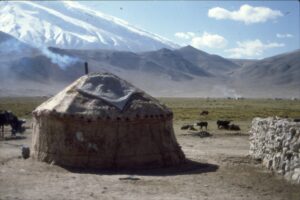
I’ve often considered past lifestyles through the filter of the essential requirements of life. Food, heat, shelter – things like this remind me that we are not that different from the people of the past, we just have different ways of fulfilling our needs.
All of these elements relate strongly to material culture. They leave a direct trace that is usually discernible by archaeologists. While our present circumstances have very real archaeological potential (a layer of facemasks?), some aspects of coronavirus are less visible. I do wonder how our present days will be marked in the future archaeological record. Living, on and off, under lockdown for the past year has made me consider less tangible human needs and wonder how universal they are and how they might manifest in the archaeological record.
Firstly, the need to socialise. It occurs to me that this is more or less universal, not least because of the way in which many societies use restrictions to the ability to socialise as a punishment or taboo. We are lucky because by and large we can keep in touch with friends and family remotely, using one of the many online platforms available to us. But, it is not quite the same as physical contact, and I long for the time when I can meet up with folk without thinking of the consequences, or the weather. In the archaeological record socialising is curiously obvious and invisible. Some sites, such as aggregation sites, suggest gatherings: assemblies; markets; communal kill sites, all have been postulated using archaeological evidence, sometimes mixed with documentary research. There are drinking vessels, feasting cauldrons, communal structures, and ceremonial monuments; all of which have been interpreted as indicating a role for social contact of various forms. Other elements of social activity: the chit chat of a couple of friends; the gossipy circle of a group of mates; family conversations inside the house, these are much more difficult to evidence – though, by and large, we assume they took place.
Secondly, the need to move around. While travel, per se, tends to be equated with money and leisure in modern society, I think we can argue for a basic inbuilt need for some degree of mobility. There are, of course, examples of families that have never left their valley, or individuals who live a couple of streets from the house of their birth – but these are the exceptions rather than the norm. We know of them because they are unusual. We take a level of mobility for granted, whether that is the right to travel for leisure, to visit family, to shop, to work, or to holiday. Archaeologically, there is, in more recent times, a suite of material culture devoted to mobility. Earlier periods have their own studies of mobility using different elements of the archaeological record to infer connections. For those of us who have been confined to a restricted geographical area for the past year, it has been a weird sensation, not helped by uncertainty over our return to the patterns of travel that we had come to regard as normal. I have, perhaps, focussed on the apparently intrinsic mobility of the hunter-gatherer lifestyle that I study in Mesolithic Scotland rather than recognising the qualities of mobility inherent in all lifestyles. This is something I want to think about some more.
Thirdly, and finally, there is the need to plan ahead. Lockdown has been hard because it has removed our (apparent) control over our future. We do not have the ability to stop (or even control) the virus, nor do we have the information to predict when life will return to normal. We like to plan: a cinema trip; a visit to granny; an afternoon by the sea; a holiday, dates like these punctuate our weekly routine and help us to envisage the passage of time. It is much harder to mark the passing of the days when using the few events left to us: a supermarket delivery; a zoom call; fish and chips; Easter. There is little real differentiation when all take place in the same limited company, in the familiar surroundings of your sitting room. Even the school holidays look like the term-time. There is a certain amount of discombobulation about this, and it is compounded by the way in which we have had to hand responsibility over our lives to others. For the first time ever, it is not possible to provide the data ourselves when filling in the calendar. Allowing this sort of control over ourselves is nerve-wracking. Archaeologically, we can infer forward planning as, for example, in an agricultural society that sets aside a time for harvest, or a hunting group that set out for seasonally related killing grounds. We can investigate ceremonial monuments and suggest a link to future-proofing the success of the community. In more recent periods we can see specific applications of technology that indicate the measurement of hours and days. It is hard to imagine a society that does not look ahead.
Personally, I have been lucky in that the very tangible necessities of food, heat, and shelter have all been assured for me over the last year. Others have not been afforded that luxury as we have seen in arguments regarding the feeding of school-age children, or extension of universal credit benefits. Erosion of the intangible necessities is, however, more widespread and more invidious. It is unlikely that life will ever return to the old familiar, if flawed, routines, and it will, no doubt, be a while before we settle into a new normal. Recovery is unlikely to be universal, and it will, no doubt, reflect considerable inequality within individual societies and around the world. Some have noted how the (very tangible and archaeologically discernible) vaccine is actually offering a (very intangible and archaeologically invisible) concept: hope. Others have noted how introspective we have all become. This, I guess, is my archaeological contribution.
You must be logged in to post a comment.